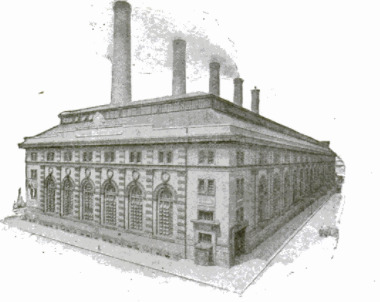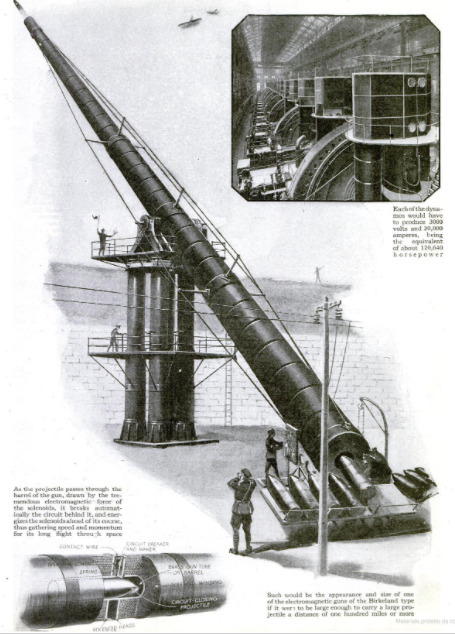-
Titolo
-
Is the creation of an electromagnetic gun practiable?
-
Article Title and/or Image Caption
-
Title: What Next? The Electromagnetic Gun?
-
Subtitle: But perhaps we have had our last world war
-
extracted text
-
IF the bombardment of Paris from a
distance of more than seventy
miles served any useful purpose
at all, it was that of calling attention
to the limitations of modern artillery.
Through the popular press of the
country, the public has learned that
every gun—and, above all, the huge
piece that shelled Paris —is short-lived.
Sir Robert A. Hadfield, England's
greatest steel-maker, once stated that
the actual firing life of a gun is less
than three seconds. Why? Whenever
the gun is fired (and it can be fired
scarcely more than two hundred
rounds), the hot powder gases wash
away the steel lining of the gun-
barrel as if it were so much wax.
Apart from the difficulties encoun-
tered because of erosion, as this
washing away of the steel is called,
ordnance officers would hesitate about
building a great gun because of other
difficulties encountered. A range of
more Luan seventy miles can be ob-
tained only by enlarging the powder-
chamber so that enormous charges of
explosives can be used, and by length-
ening_the barrel for the purpose of
enabling the powder gases to act for a
longer time on the projectile. If the
barrel is inordinately lengthened, spe-
cial machinery must be invented to
turn it.
Theoretically, there is no limitation
toincreasing the size, caliber, and range
of guns; but it requires more than mere
theory to build guns that are efficient
for the purposes of war. Guns must be
made of some material, and, un-
fortunately, there are limitations to the
physical strength of every material
known to man. Once upon a time
guns were made of leather or wood;
but, as the range and power of the
guns was increased, stronger and ever
stronger materials had to be found to
resist, the increasing strain.
Medium-Sized Guns Most Effective
In the last fifty years the evolution
of artillery has made rapid progress.
Chemistry, physics, metallurgy, and
engineering were pressed into service
and contributed their share to the
marvelous development of this par-
ticular and most scientific arm. But
scientists are inclined to believe that
the limits of possibility in the evolu-
tion of the present type of ordnance
has nearly been reached.
‘The building of bigger guns is limited
by considerations of a
technical nature. The
larger the gun, the
slower the fire. This
is a serious draw-
back. Practice
teaches that medium-
sized guns are the
most effective.
The monster guns
of the most recent
type are as big as
can be built with the steel presses
and convertors now n use, “To viewed
the present muzzle speeds of projec-
tiles, explosives of greater power must
bo found. However, the known laws
of the expansion of guses do not sug-
est the possibility of obtaining a gas
pressure behind a projectile that will
propel it at an initial speed much above
4,000 feet a second. The erosive power
of high explosives must also be taken
into account.
The Electromagnetic Gun
Bocausa steel in no easily washed
away by powder guses, because big
guns aro so difficult to make, attention
has onco more heen directed to_ the
electromagnetic guns proposed. from
time to time by engineers.
The electromagnetic gun is extromo-
ly simple in principle. Any magnot
attracts a plece of steel. Suppose that
electromagnets were arranged in a row,
#0 that the first would attract a steel
projectile, then the second, the third,
the fourth, ote, until finally the
projectile would be hurled into space.
Tt nounda very simple, doesn't it?
Saver guns of that type have been
invented and patented. An thy aro
based upon the same princlpie,—u
principle that allows but litle latitude
in the method of ita application, —tho
guns invented by Professor Kristian
Birkeland, Levi M, Bowman, Ell M.
Alderman, Paul T. Kenny, Foster, and
a fow others differ mainly in tho ar-
rangement of the solenoids and in the
‘method employed to cut out the electric
current from the electromagnets after
the projectile has passed them.
Professor _ Birkeland's invention,
probably the most important of its
kind so far patented, contemplates
a gun-barrel mado of bronze or steel,
which ia surrounded by solenoids.
These solenolds are supplied with an
abnormally heavy current, that is to
say, a current beyond the capacity of
the solenoids as calculated by the
‘methods now in vogue for determining
the safe carrying capacity of a coil.
‘According to the plan of the inven-
tor, the heavy current that energizes
the first solenoid is shut off by the pro-
jectile as it reaches the coils toward
which it ia drawn by the magnetic
force of the solenoid. At the same
time, the next group of solenoids is
energized. The magnetic force of the
energized colls acts upon the iron pro-
jectile and adds to its speed; but again
the current is cut off by the projectile
before it has time to raise the tem-
perature of the solenoid to a degree
high enough to destroy it.
Is It Practicable?
The inventor calculates that for
throwing an iron projectile weighing
two tons and containing 1000 pounds
of nitrogelatine at an initial speed of
one thousand feet a second, a gun
about ninety feet in length would be
required. The projectile would be
about nine feet long and nineteen
inches in diameter. The gun solenoids
may be made up of square wire, each
‘solenoid containing 720 windings witha
resistance of fifteen ohms. The length
of each solenoid is made about three.
eighths of an inch and the height about
cight inches. With an electromotive
force of 3000 volts, this will give a
current of 200 amperes.
Major-General William M. Black,
Chief of Engineers, U.S. A. does not
believe in the feasibility of such a gun.
At the thirty-fourth annual convention
of the American Institute of Electrical
Engineers, in June, 1918, he said:
“You can understand theimpracticabilty
of transporting the electrical plants required
for any number of such guns. 1 think
that you will agree that, until new dis-
coverln give a much improved method of
Storing of generating clectricty, smokeless
powder will continue to be the mast. com-
Pact and convenient form of stored energy
for guns”
-
Lingua
-
eng
-
Data di rilascio
-
1919-02
-
pagine
-
18-19
-
Diritti
-
Public domain (Google digitized)
-
Archived by
-
Davide Donà
-
Marco Bortolami (editor)



